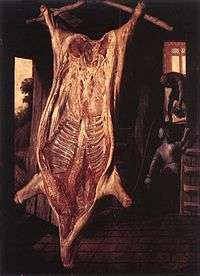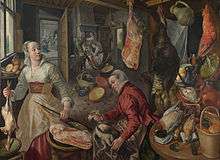Joachim Beuckelaer

Joachim Beuckelaer (c. 1533 – c. 1573/4) was a Flemish painter specialising in market and kitchen scenes with elaborate displays of food and household equipment.[1]
Life
Beuckelaer was born in Antwerp and possibly learned to paint in the workshop of his uncle, Pieter Aertsen, who had married his aunt.[2] Aertsen was best known for his market and kitchen scenes, genres which Beuckelaer continued to paint when he established himself as an independent master in 1560.[3]
Work
His market scenes, like Aertsen's, often incorporate biblical episodes into the background.[4] His Four Elements series, acquired by the National Gallery, London in 2001,[5] exemplifies this on a large scale. Water, for example, shows a fish market selling twelve kinds of fish, representing the twelve disciples of Jesus. Through an archway in the background Christ can be seen walking on the Sea of Galilee after his resurrection, making fish appear miraculously in empty nets.

Both Aertsen and Beuckelaer gradually developed images that detached the world of produce from the religious content of their earlier hybrid images. These later works depict either kitchens or markets and the persons associated with those activities, more often women than men. The later paintings by Beuckelaer show a greater profusion of foodstuffs in the market scenes, together with a more prominent foregrounding of female peasants immersed within these sales items. Beuckelaer also produced several images of fish stalls, often with background religious scenes, but sometimes completely separated from any additional narrative or reference.[6]
During the 1560s, especially during the early part of the decade, he painted some purely religious works, for which, unlike the kitchen and market scenes, drawings are known. In this period he also made designs for stained glass.[6]
Beuckelaer was also employed painting the figures in the work of other artists such as Anthonis Mor and Cornelis van Dalem.[3][2] The 17th century biographer Karel van Mander claimed that the artist was only able to sell his paintings at low prices, and that they only became prized after his death.[3] However, the large size of his later works and the number of workshop variants produced has been taken as an indication of a degree of success at least towards the end of his life.[7]
His still life of a carcass called Slaughtered Pig dated 1563 is likely the earliest dated example of this subject.[2]
Research into the technique underlying Beuckelaer’s canvases has shown that he often recycled compositions of his produce from one image to the next. He employed patterns of clustered items through tracings to compose new pictures with apparent variety. This kind of technique allowed him to increase production efficiency and cut costs in time and effort.[6]
His work was influential on painters in Northern Italy, particularly Vincenzo Campi .
References
 | |
|
| |
|
|
- ↑ The Collector's Cabinet: Flemish Paintings from New England Private Collections, Univ of Massachusetts Press, 1983, pp. 16–19
- 1 2 3 Joachim Beuckelaer at the Netherlands Institute for Art History (Dutch)
- 1 2 3 "Joachim Beuckelaer". Rijksmuseum. Retrieved 25 October 2012.
- ↑ "Joachim Beuckelaer". National Gallery. Retrieved 25 October 2012.
- ↑ "Key Facts". National Gallery. Retrieved 25 October 2012.
- 1 2 3 Wolters, Margreet. "Drawing → Underdrawing → Painting: Compositional Evolution in the Working Process of Joachim Beuckelaer" (PDF). Journal of Historians of Netherlandish Art.
- ↑ Silver, Larry (2006). Peasant Scenes And Landscapes: The Rise of Pictorial Genres in the Antwerp. University of Pennsylvania Press,. p. 99.
- ↑ "Symbolism in The Four Elements". National Gallery (London). Retrieved March 8, 2013.
- ↑ "The Four Elements: Air 1570". National Gallery (London). Retrieved March 8, 2013.
| Wikimedia Commons has media related to Joachim Beuckelaer. |